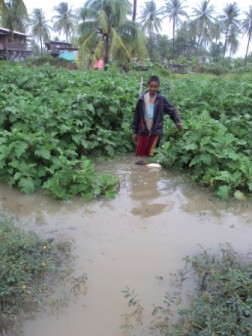Several villages in Regions Five and Six remained under floodwater yesterday following heavy and persistent rain, with some West Berbice residents fearing that they would suffer losses to their cash crops.
Minister of Agriculture Dr Leslie Ramsammy last evening said that the eastern regions of Guyana had received the highest rainfall in the lat 24 hours. He said that “The Hydrometeorological Service as at 08:00hrs on January 29, 2012 received reports from a number of its rainfall stations across the country. These reports give the total accumulated rainfall between 8:00 hrs Saturday January 28 and 8:00 hrs Sunday January 29 2012. Data collected so far indicated that many stations along the coast and near Inland locations exceeded 100mm in 24 hours. The highest recorded rainfall was 172.6 mm which was reported at New Amsterdam in Region 6. Other values exceeding the 100 mm are as follows: 152.3 mm was reported at Friendship Buxton, 125.4 mm at Enterprise, both in Region 4; 138.4 mm at Pine Ground, 116.2 mm at Wash Clothes, 100.0 mm at Bara Bara, 152 mm at Bush Lot and 106.0 at Foulis and 136.6mm at D’ Edward Village, all in Region 5.”
He said the outlook over the next 48 hours indicates that the current conditions will be sustained with “light to moderate intermittent rainfall”. He said that rainfall quantities are likely to exceed 60 millimetres in 48 hours. Dr Ramsammy added that the La Nina weather is persisting and is expected to last until the end of the first quarter this year.

West Berbice residents told this newspaper that they were distressed when they woke up yesterday morning to find that their crops were totally submerged.
Savitri Boodhoo said she and her husband Lakhan Kurhair of Bush Lot had already been reaping from their garden which had 5,000 tomato plants, 100 roots of corilla, 500 roots of boulanger and 1,000 sweet pepper plants.
Another resident, Paul Ramcharran was also trying hard to save his crop which included tomatoes and sweet peppers. He started pumping water out of his farm since 4 am and was praying that everything would be alright.
Some residents said they were faced with more than ankle-deep water in their yards and kitchens in the lower flat. They had to lift their fridges, stoves and other items and were unable to “cook in all this water; we had to buy food” from nearby Chinese restaurants.

Others said they had to relocate their stoves to the upper flat while those who cook on firesides in their yards were forced to use kerosene stoves indoors. They were also unable to use their outdoor latrines.
The residents said too that their livestock was “catching cramps and we had to loose them” to go on the dry dams, while some climbed up to safety on places like the stairs and on tables.
Regional chairman of Region Five, Bindrabhan Bisnauth and chairman of Region Six, David Armogan who took office a few days ago were faced with their first challenge but were both confident that they would be able to bring the situation under control.
They said that the rainfall was between six to nine inches in a 10 to 12 hour period but the system was only designed to drain one inch of water in 24 hours.

Further, they said the sluices can only be opened for five hours, according to the tide. They both said they are “working around the clock” to bring relief to the residents.
President Donald Ramotar and Minister Ramsammy visited Berbice yesterday to assess the situation.
Bisnauth told Stabroek News that he and a team conducted visits from Ithaca to Mahaica and it was found that the villages that were mostly affected included Blairmont Settlement, Ithaca and to a “lesser extent, the Cotton Tree area.”
He pointed out that the sluices were opened around 10 am and water started to recede. Residents were concerned though that “when the sluice closes water from the low-lying areas aback the villages would result in a build-up.”
He pointed out that he was in close discussion with officials from the Mahaica-Mahaica-Abary scheme, the National Drainage & Irrigation Authority and GuySuCo, in case the rain continues and pumping is required.
According to him, a mini excavator that the region had acquired has been deployed to accelerate drainage of the Bath area.
Regarding the Mahaica and Mahaicony Creeks, the chairman said there was flooding mostly in “the upper reaches” but it was “not alarming.” He said too that it was too early to pronounce on loss of cash crops.
Meanwhile, Armogan told SN that the residential areas in his region were mostly affected and that rice and cash crops were not under immediate threat.
He pointed out that two excavators have been deployed in two outfall channels at No 43 Village which drain the Black Bush Polder (BBP) area and at Letter Kenny. The irrigation pumps have also been cut off.
He said the most critical areas include the Rose Hall Town Reef Section which had about two ft of water as well as Canefield, Cumberland and parts of Adelphi in East Canje, Edinburgh on the East Bank Berbice and Chesney, Albion and No. 19 Village on the Corentyne.
According to him, GuySuCo pumps have already started working in some of the critical areas and he was also trying to get more pumps
He lamented that a pile-up food boxes and plastic bags in the drainage systems contributed to the flooding and called on residents to “take greater responsibility” in disposing their garbage.
Armogan said that the upper Corentyne areas including Crabwood Creek and Corriverton were not affected that badly while the water is receding faster in NA than in the other areas. He said too that flooding in Black Bush Polder seems to be under control.
A resident of Gordon Table, Mahaicony Creek told this newspaper that the rice and cash crops in the area are under threat. He said too that everywhere is covered with water and that the livestock does not have any grass to feed on.
According to him, the rain started from around 7:15 pm on Saturday and continued to pour almost “non-stop.”





